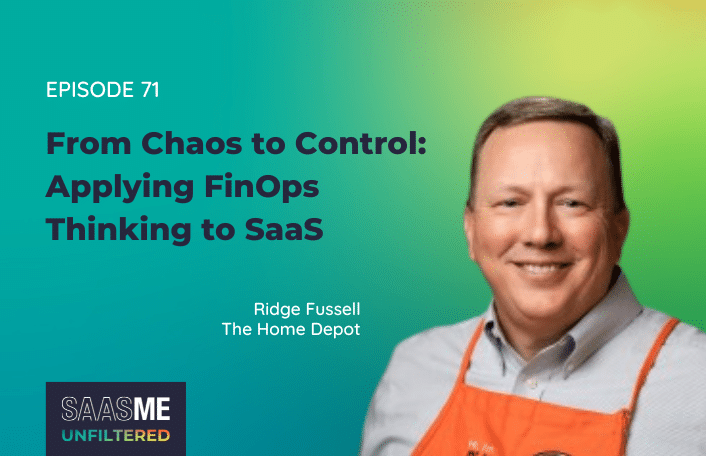
How to Build a Savings Pipeline for SaaS Renewals
Table of Contents ToggleWhat Is a SaaS Savings Pipeline?Why Managing SaaS...
Back
Back
Search for Keywords...
Blog

07/17/2025
Table of Contents
What happens when a cloud FinOps expert takes on the unruly world of SaaS? Ridge Fussell, Senior Manager of FinOps at The Home Depot, reveals the surprising complexity behind managing SaaS at scale—and why it’s nothing like managing cloud. In this episode, learn why SaaS Management requires a different mindset and the first step you need to take to gain control and drive value.
Chapters:
Ridge Fussell knows FinOps. But when he took on SaaS at The Home Depot, it was a different story.
The team assumed they had things under control. Then the data told a different story: duplicate tools, unidentified owners, and spend in places no one expected. “We thought we had a pretty good hand on it. And we had no idea,” Ridge says.
So they got to work. Step one: visibility. Ridge built a partnership-driven program that connected finance, procurement, security, and architecture. They launched a 120/90/60/30 renewal playbook. They surfaced usage data. They brought facts to the table—and got buy-in from teams across the business.
“You’ve got a problem,” Ridge says. “You just don’t know that it’s a problem yet.”
This episode walks through Ridge’s journey from assumption to action. It’s a clear look at what it takes to apply FinOps thinking to SaaS—and where most companies are still stuck.
Name: Ridge Fussell
What he does: Senior Manager of FinOps at The Home Depot
Connect with Ridge online: LinkedIn
Moving from cloud to SaaS FinOps revealed just how much Ridge and his team didn’t know—and weren’t prepared for.
“We presumed that coming into it, we kind of knew everything. Matter of fact, when Zylo first partnered with us, one of the questions was: how bad do you think the problem is? And our response, kind of smart aleck-y or not, was, we think we probably got most of it under control. We knew there would be some things out there, but we thought we had a pretty good hand on it. And we had no idea. One of the presumptions around that is you don’t know what you’ve got, even though you think you do. Pulling that data in and starting to understand it is one step of this. But then the other presumption was, even when we find everything that’s out there, we will know who owns everything—which has been another problem. It’s been a year-long battle of trying to go out there and find everything that we’ve got. And without getting to the numbers, it’s multiples of what we thought we had.”
Before any optimization could happen, Ridge focused on discovery, surfacing unknown tools, spend, and owners.
“With a SaaS perspective, you don’t even know what that looks like. And I can tell you, whether people think or don’t think they have a problem, I’m promising you do have a problem, because you don’t know what you’ve got in the environment. That’s part of the big issue here. SaaS from a FinOps perspective is not just taking what you know and allocating it out. It’s actually bringing it in so that you know what you’ve got. And that’s got to be the first step—because without knowing what you’ve got in your environment, there’s no way you can control it, manage it, or allocate it.”
To avoid a heavy-handed approach, Ridge’s team implemented a renewal process that added structure without removing ownership.
“We’re not trying to take any power away from anybody. We’re not wanting to take ownership away. In fact, one of the things we’re doing is identifying owners for all of these things. Because we don’t want to own it from a SaaS COE perspective. We’re not the business that’s getting the benefit out of it. What we’re wanting to do is make sure that everybody’s following a similar process. So we created a very nice, we call it the four steps—the 120, 90, 60, 30 days from either renewal or acquisition. Here’s the things you need to be doing to more efficiently spend the Home Depot dollars. We still want you to maintain your ownership and responsibility for the tools. We’re just putting a couple of little speed bumps—not roadblocks—to help you along the way.”
Security concerns—not just financial waste—became a major driver for Ridge’s program.
“Risk is risk. It doesn’t matter what you pay for the application. You can pay $500, you can pay $5 million. They’ve got the same risk to them—particularly if you don’t know what they’re being used for. When you look at a large-scale operation, it’s going to drive problems within the organization. So that’s certainly one of them. And we’ve identified a significant amount of applications that we’ve just got to go through and get the reviews done. Probably in most cases, nothing’s going to change. They’re probably okay. The keyword being ‘probably.’ We’d rather it be definitely okay. And then there’s the cost factor. When different people are buying things and buying small quantities, I can almost guarantee you you’re paying rack rates and not taking advantage of the buying power that you’ve got—especially the company size of Home Depot.”
Trying to solve for the entire application portfolio at once slowed their progress. Ridge now recommends a more focused approach.
“If I could go back 15 or 16 months when we started this, I’d probably start with a smaller subset. You still have to identify what you’ve got, but once you’ve done that, I would focus on maybe the top 10, 12, 15 applications and go in and nail those down, get those really, really good, and then move on to another set. I think trying to do a lot all at one time made it really difficult. We’ve learned through this process. We had some stop-and-starts and some changes in methodology. But we’ve now got a daily scrum, we’ve got separate conversations around renewals. We’re kind of doing what we should have done a year ago. And once those tools are integrated, people understand the process, then we’re good going forward. You just have to check in at renewal. And then you can focus on the new stuff that pops up.”
If you’re a FinOps pro just beginning your SaaS Management journey, Ridge’s story is a masterclass in what it takes to turn unknowns into action.
Want more stories like this? Subscribe to SaaSMe Unfiltered on your favorite podcast platform.
The Definitive Guide to SaaS Management
Learn MoreABOUT THE AUTHOR

Cory Wheeler
As Zylo’s Chief Customer Officer, Cory is responsible for helping our customers drive ROI and SaaS Management success with Zylo. He helps companies of all sizes effectively discover, optimize, and govern their SaaS through Zylo’s platform and services. Prior to founding Zylo, Cory spent 15 years in finance and procurement, managing categories and sourcing teams at Arthur Andersen, BearingPoint, and both Takeda and Astellas Pharmaceuticals. He built the procurement organization at ExactTarget, and managed the integration with the Salesforce Marketing Cloud procurement organization in 2015. He and his family reside in Indianapolis, IN, where they can be found cheering for the Purdue Boilermakers and Chicago Cubs.

Table of Contents ToggleWhat Is a SaaS Savings Pipeline?Why Managing SaaS...

Table of Contents ToggleWhat FinOps Means in the Modern Cloud EnvironmentWhy...

Table of Contents ToggleEpisode SummaryGuest SpotlightEpisode Highlights1. Cloud Finops Doesn’t Prepare...

Table of Contents ToggleEpisode SummaryGuest SpotlightEpisode Highlights1. Cloud Finops Doesn’t Prepare...
| Cookie | Duration | Description |
|---|---|---|
| cookielawinfo-checkbox-analytics | 11 months | This cookie is set by GDPR Cookie Consent plugin. The cookie is used to store the user consent for the cookies in the category "Analytics". |
| cookielawinfo-checkbox-functional | 11 months | The cookie is set by GDPR cookie consent to record the user consent for the cookies in the category "Functional". |
| cookielawinfo-checkbox-necessary | 11 months | This cookie is set by GDPR Cookie Consent plugin. The cookies is used to store the user consent for the cookies in the category "Necessary". |
| cookielawinfo-checkbox-others | 11 months | This cookie is set by GDPR Cookie Consent plugin. The cookie is used to store the user consent for the cookies in the category "Other. |
| cookielawinfo-checkbox-performance | 11 months | This cookie is set by GDPR Cookie Consent plugin. The cookie is used to store the user consent for the cookies in the category "Performance". |
| viewed_cookie_policy | 11 months | The cookie is set by the GDPR Cookie Consent plugin and is used to store whether or not user has consented to the use of cookies. It does not store any personal data. |
